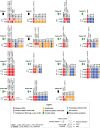The clonal relation of primary upper urinary tract urothelial carcinoma and paired urothelial carcinoma of the bladder
- PMID: 33006377
- PMCID: PMC7821318
- DOI: 10.1002/ijc.33327
The clonal relation of primary upper urinary tract urothelial carcinoma and paired urothelial carcinoma of the bladder
Abstract
The risk of developing urothelial carcinoma of the bladder (UCB) in patients treated by radical nephroureterectomy (RNU) for an upper urinary tract urothelial carcinoma (UTUC) is 22% to 47% in the 2 years after surgery. Subject of debate remains whether UTUC and the subsequent UCB are clonally related or represent separate origins. To investigate the clonal relationship between both entities, we performed targeted DNA sequencing of a panel of 41 genes on matched normal and tumor tissue of 15 primary UTUC patients treated by RNU who later developed 19 UCBs. Based on the detected tumor-specific DNA aberrations, the paired UTUC and UCB(s) of 11 patients (73.3%) showed a clonal relation, whereas in four patients the molecular results did not indicate a clear clonal relationship. Our results support the hypothesis that UCBs following a primary surgically resected UTUC are predominantly clonally derived recurrences and not separate entities.
Keywords: bladder carcinoma; clonality; upper urinary tract carcinoma; urothelial carcinoma.
© 2020 The Authors. International Journal of Cancer published by John Wiley & Sons Ltd on behalf of Union for International Cancer Control.
Conflict of interest statement
J. L. Boormans reports on consultancy work for MSD, Janssen, Ambu, Health care and Ismar, during the conduct of the study; and received a research grant from Decipher Biosciences. All other authors report no conflict of interest.
Figures

Similar articles
-
Synchronous and metachronous urothelial carcinoma of the upper urinary tract and the bladder: Are they clonally related? A systematic review.Urol Oncol. 2020 Jun;38(6):590-598. doi: 10.1016/j.urolonc.2020.01.008. Epub 2020 Feb 11. Urol Oncol. 2020. PMID: 32057596
-
Clonal Relatedness and Mutational Differences between Upper Tract and Bladder Urothelial Carcinoma.Clin Cancer Res. 2019 Feb 1;25(3):967-976. doi: 10.1158/1078-0432.CCR-18-2039. Epub 2018 Oct 23. Clin Cancer Res. 2019. PMID: 30352907 Free PMC article.
-
Genomic Characterization of Upper Tract Urothelial Carcinoma.Eur Urol. 2015 Dec;68(6):970-7. doi: 10.1016/j.eururo.2015.07.039. Epub 2015 Aug 14. Eur Urol. 2015. PMID: 26278805 Free PMC article.
-
Risk factors for intravesical recurrence after radical nephroureterectomy for upper tract urothelial carcinoma: a meta-analysis.Urol Oncol. 2014 Oct;32(7):989-1002. doi: 10.1016/j.urolonc.2014.01.022. Epub 2014 Jul 28. Urol Oncol. 2014. PMID: 25082191
-
Oncological Outcomes of Laparoscopic Nephroureterectomy Versus Open Radical Nephroureterectomy for Upper Tract Urothelial Carcinoma: An European Association of Urology Guidelines Systematic Review.Eur Urol Focus. 2019 Mar;5(2):205-223. doi: 10.1016/j.euf.2017.10.003. Epub 2017 Nov 15. Eur Urol Focus. 2019. PMID: 29154042
Cited by
-
Kidney-Sparing Surgery for Upper Tract Urothelial Carcinoma-Modalities, Outcomes, and Limitations.J Clin Med. 2024 Nov 2;13(21):6593. doi: 10.3390/jcm13216593. J Clin Med. 2024. PMID: 39518735 Free PMC article. Review.
-
Predictive Value of Preoperative Positive Urine Cytology for Development of Bladder Cancer After Nephroureterectomy in Patients With Upper Urinary Tract Urothelial Carcinoma: A Prognostic Nomogram Based on a Retrospective Multicenter Cohort Study and Systematic Meta-Analysis.Front Oncol. 2021 Oct 1;11:731318. doi: 10.3389/fonc.2021.731318. eCollection 2021. Front Oncol. 2021. PMID: 34660295 Free PMC article.
-
Factors Predicting Oncological Outcomes of Radical Nephroureterectomy for Upper Tract Urothelial Carcinoma in Taiwan.Front Oncol. 2022 Jan 13;11:766576. doi: 10.3389/fonc.2021.766576. eCollection 2021. Front Oncol. 2022. PMID: 35096575 Free PMC article.
-
Strategies to reduce bladder tumor recurrences following surgery for upper tract urothelial carcinoma.Bladder (San Franc). 2024 Jul 31;11(1):e21200001. doi: 10.14440/bladder.2024.0007. eCollection 2024. Bladder (San Franc). 2024. PMID: 39301574 Free PMC article.
-
Improved Disease-Free Survival With Adjuvant Chemotherapy After Nephroureterectomy for Upper Tract Urothelial Cancer: Final Results of the POUT Trial.J Clin Oncol. 2024 May 1;42(13):1466-1471. doi: 10.1200/JCO.23.01659. Epub 2024 Feb 13. J Clin Oncol. 2024. PMID: 38350047 Free PMC article. Clinical Trial.
References
-
- Roupret M, Babjuk M, Burger M, et al. European Association of Urology Guidelines on upper urinary tract urothelial carcinoma: 2020 update. Eur Urol. 2020. - PubMed
-
- Harris AL, Neal DE. Bladder cancer—field versus clonal origin. N Engl J Med. 1992;326:759‐761. - PubMed
-
- Habuchi T. Origin of multifocal carcinomas of the bladder and upper urinary tract: molecular analysis and clinical implications. Int J Urol. 2005;12:709‐716. - PubMed
-
- van Doeveren T, van de Werken HJG, van Riet J, et al. Synchronous and metachronous urothelial carcinoma of the upper urinary tract and the bladder: are they clonally related? A systematic review. Urol Oncol. 2020;38(6):590‐598. - PubMed
-
- Pruis MA, Geurts‐Giele WRR, von der TJH, et al. Highly accurate DNA‐based detection and treatment results of MET exon 14 skipping mutations in lung cancer. Lung Cancer. 2020;140:46‐54. - PubMed
Publication types
MeSH terms
LinkOut - more resources
Full Text Sources
Medical

